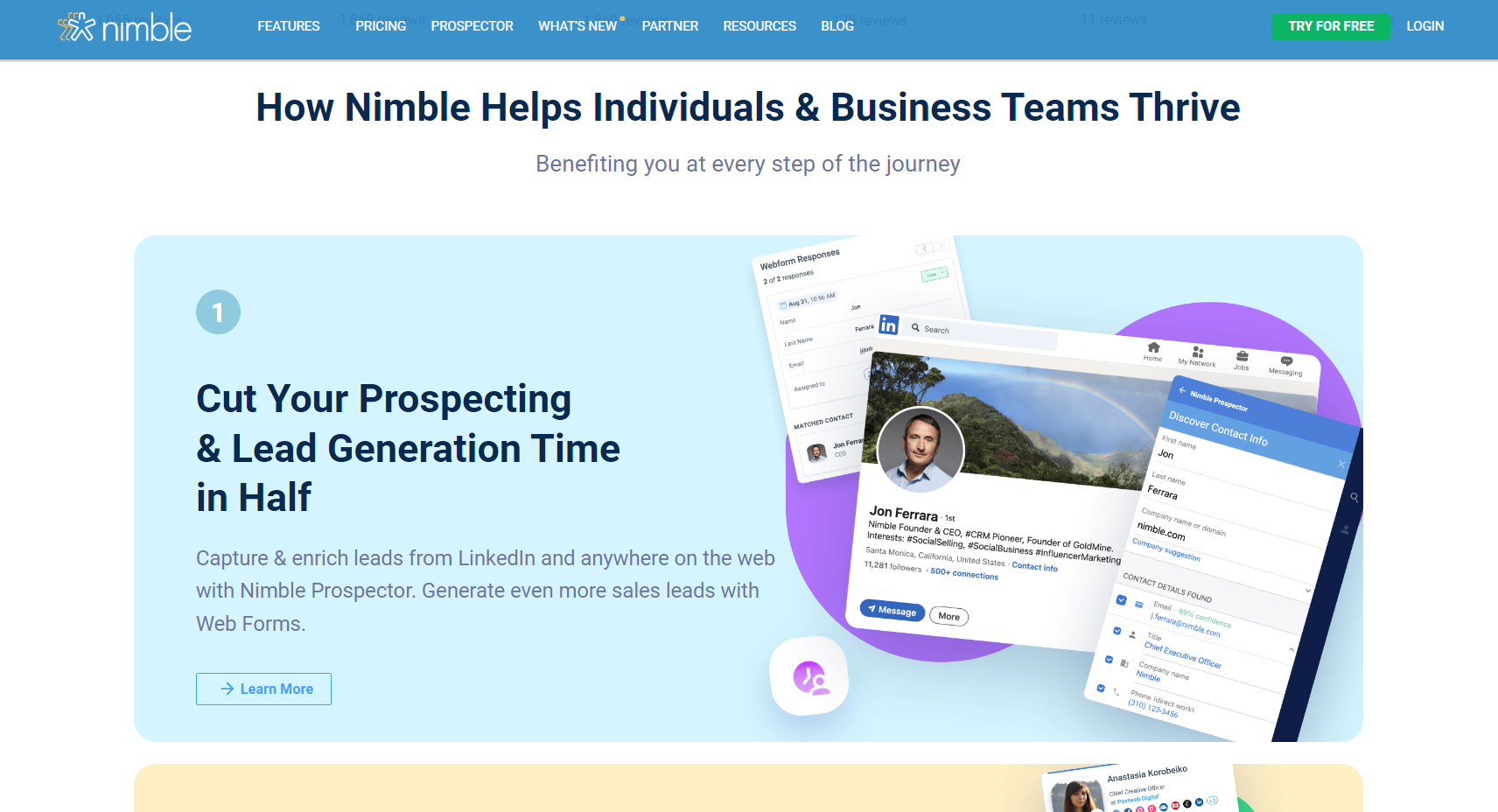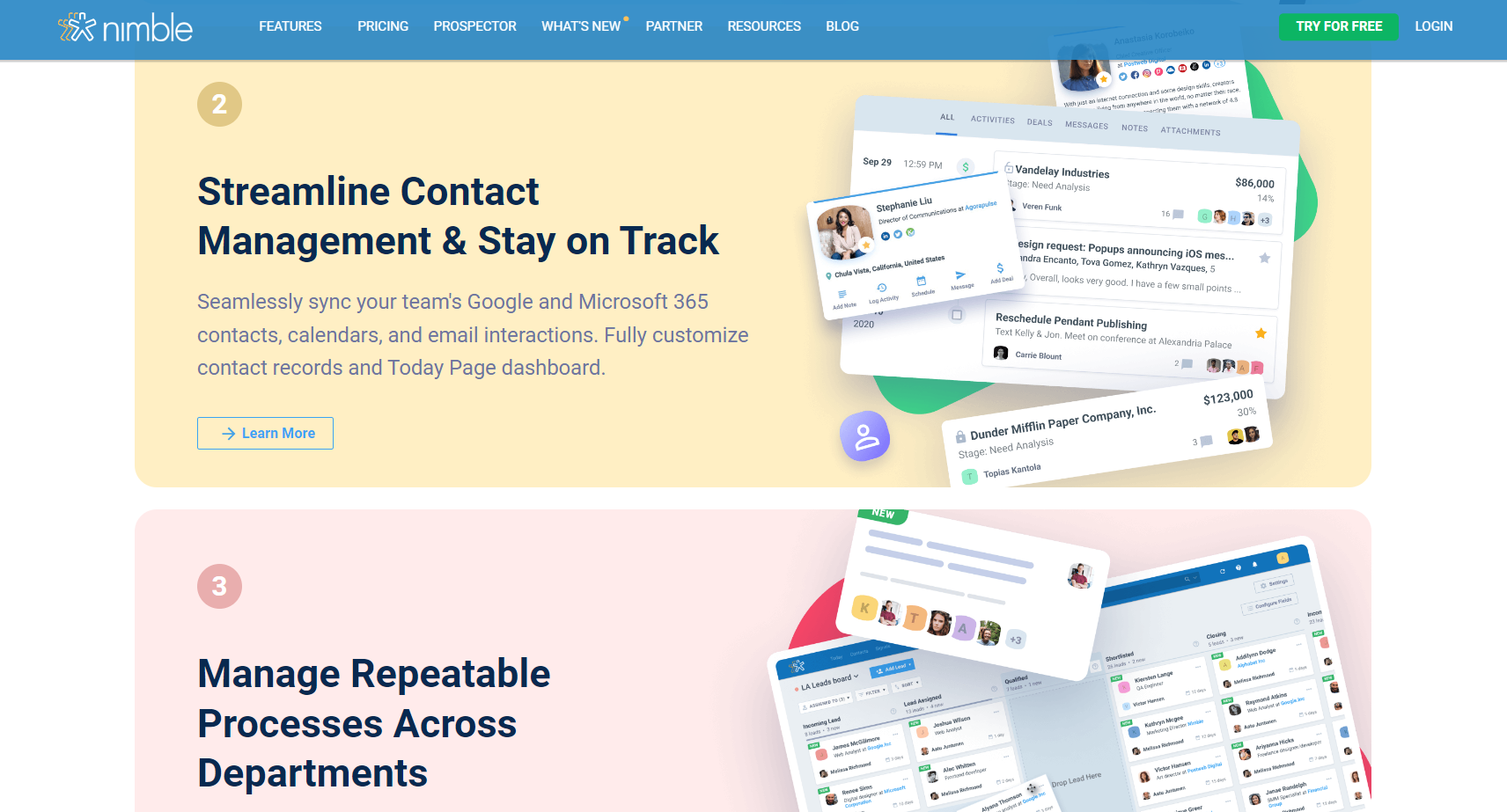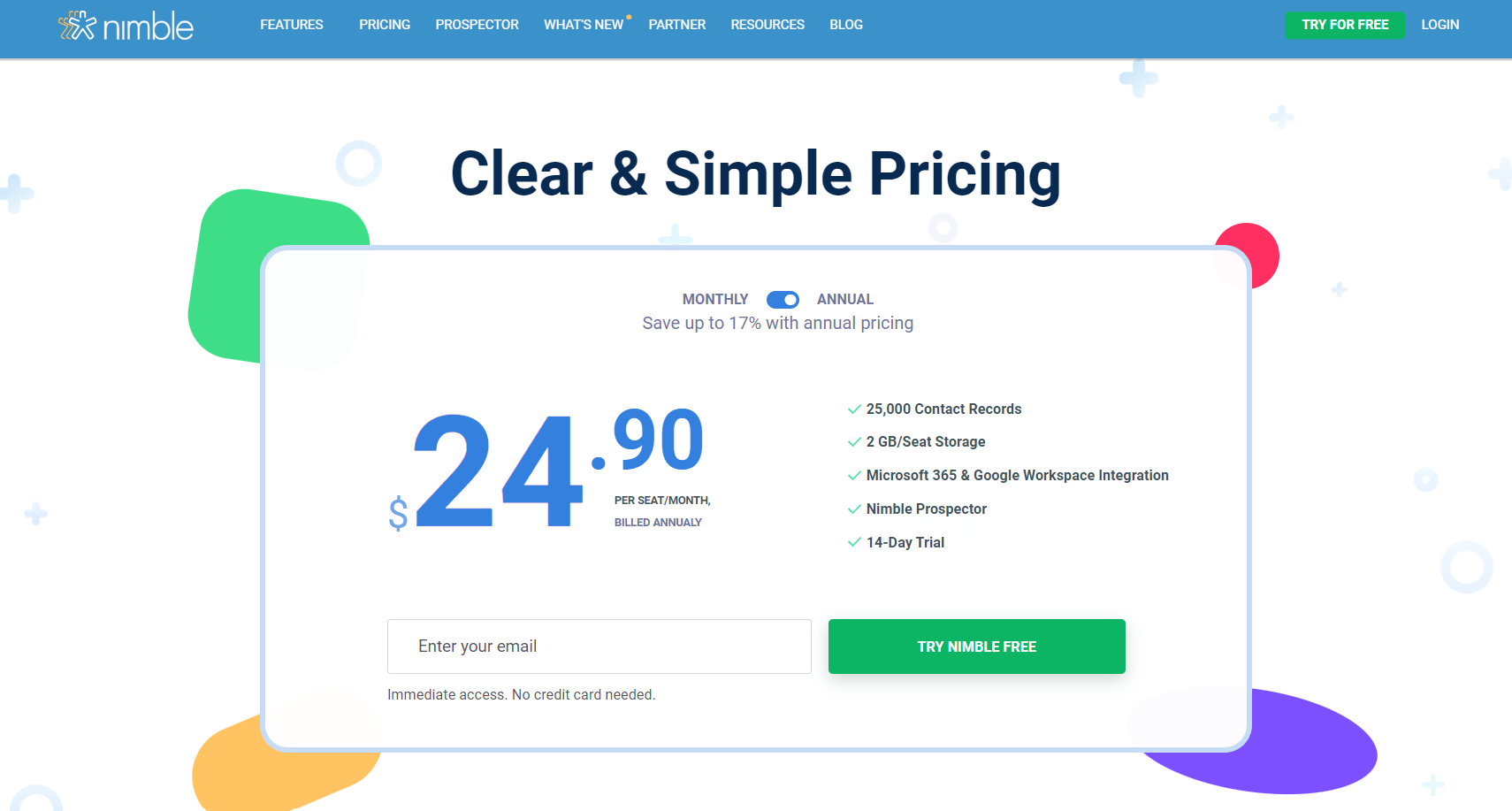Nimble CRM offers a specialized platform tailored for businesses focused on effective lead generation and relationship management. With its robust social media integrations, automatic data enrichment, and customizable sales pipelines, Nimble enables users to cultivate and convert leads with precision and efficiency.
The platform’s ease of use, combined with its rich insights and automation capabilities, makes it a strong contender for businesses looking to enhance their lead nurturing processes. However, its pricing, starting at $24.90 per user per month, may be a consideration for smaller businesses, and the limited storage and support options could be restrictive for those requiring more extensive resources.
If your business values deep insights into leads and streamlined contact management, Nimble could be a strategic investment to elevate your lead generation efforts.
>>> MORE: Monday.com CRM vs Pipedrive
Let’s Cut to the Chase!

Buy Nimble Lead Generation If:
- You want an all-in-one solution that not only captures leads but also enriches them with detailed social and business data, providing deeper insights into your prospects.
- You value an intuitive and user-friendly interface that simplifies the process of managing leads, even for teams without extensive technical expertise.
- You’re looking for a CRM that supports mobile access so your team can capture and manage leads on the go, ensuring no opportunities are missed.
- You prioritize seamless integration with social media platforms like LinkedIn, allowing you to automatically import and update contact details, which enhances your ability to connect with and convert leads.
- You need a CRM that offers customizable sales pipelines and automated workflows, enabling you to manage and nurture leads more efficiently, tailored to your specific business needs.
Do Not Buy Nimble Lead Generation If:
- You expect a free or very low-cost option that fits a tight budget, as Nimble’s pricing might be less attractive.
- You need a more specialized tool solely focused on lead generation, without the additional CRM features that might feel unnecessary or overwhelming for your specific needs.
- You require highly advanced reporting and predictive analytics, as Nimble’s analytics capabilities may not meet the demands of businesses needing deeper data insights.
- You’re looking for a platform that integrates with very niche or industry-specific tools.
- You operate a very large enterprise with complex sales processes, which might require a more tailored CRM solution designed to handle the intricate needs of large-scale operations.
THE BOTTOM LINE
Nimble offers a versatile and user-friendly CRM platform designed to enhance lead generation and relationship management for businesses of all sizes. With its intuitive interface, robust social media integration, and seamless integration with popular productivity tools, Nimble simplifies the process of managing contacts, tracking interactions, and nurturing leads. While it may not have the advanced analytics or highly specialized features of some enterprise-level CRMs, Nimble is an excellent choice for small to medium-sized businesses seeking a cost-effective and efficient solution to streamline their lead generation and customer relationship processes
Now, Let’s Detail Things for You
Nimble offers a straightforward pricing model with a single plan, priced at $24.90 per user per month when billed annually, or $29.90 per user per month if you prefer the flexibility of month-to-month billing. This plan grants full access to Nimble’s extensive feature set, which includes relationship management with automatic data enrichment, customizable sales pipelines, email sync, email marketing, and advanced reporting capabilities.
Unlike some competitors, Nimble doesn’t have a free tier, which could be a drawback for businesses on a tight budget. For comparison, Zoho CRM, a close competitor, offers a free plan and paid options starting at $14 per user per month with annual billing, nearly half the price of Nimble’s plan. Pipedrive also presents a more affordable alternative, starting at $14 per user per month, with similar features like contact management and sales pipelines, though it lacks Nimble’s advanced data enrichment capabilities.
What’s the Catch with Nimble Lead Generation?

Nimble’s Lead Generation pricing might initially seem straightforward, but there are a few points to consider before fully committing. Nimble offers tiered pricing based on the number of leads and the level of service provided, with plans starting at a seemingly reasonable rate. However, as businesses grow and require more extensive lead generation, the costs can increase significantly.
One potential drawback is that the base plan may offer only limited features, requiring upgrades for essential tools like advanced CRM integration, detailed analytics, or premium support. Additionally, businesses with a high volume of leads might face additional charges, which could make the overall cost of using Nimble higher than anticipated. There’s also the consideration of hidden fees for add-ons or premium features that aren’t included in the standard pricing, which could escalate the total expenses.
What You Need to Know
Nimble offers a straightforward pricing model with a single plan that includes access to all of its features. This approach simplifies decision-making by avoiding the confusion of multiple tiers with varying features. Here’s a closer look at the details:
- Monthly Plan: $29.90 per user, per month. This plan is billed on a month-to-month basis, providing flexibility for businesses that prefer not to commit long-term.
- Annual Plan: $24.90 per user, per month, billed annually. This option requires an upfront payment for the entire year, resulting in a lower monthly cost compared to the month-to-month plan.
>>> PRO TIPS: CRM Software – Why Use It?
What are Nimble Lead Generation Competitors Offering?

Nimble vs. HubSpot: Nimble excels in its social CRM capabilities and data enrichment features, offering unique insights into contacts by pulling information from social profiles. HubSpot, on the other hand, provides a comprehensive suite of CRM and marketing tools, including advanced automation, email marketing, and content management. HubSpot is well-suited for businesses seeking an all-in-one solution with a strong emphasis on inbound marketing, while Nimble is better for those who value detailed social data integration.
Nimble vs. Zoho CRM: Nimble stands out for its intuitive interface and automatic social data enrichment, which helps in building and maintaining detailed contact profiles. Zoho CRM offers a broader range of features, including inventory management, advanced automation, and a free plan for basic CRM needs. Zoho CRM is more versatile and budget-friendly, making it a strong competitor for businesses needing a wide array of CRM functionalities, while Nimble is preferred for its ease of use and focus on social data.
Nimble vs. Pipedrive: Nimble provides strong social media integration and data enrichment features, enhancing lead management and relationship building. Pipedrive specializes in sales pipeline management with a user-friendly interface and extensive automation options. Pipedrive is ideal for businesses focused on optimizing their sales processes and pipeline visibility, while Nimble is better suited for those looking for enriched contact data and a broader view of customer relationships.
Nimble vs. Freshsales: Nimble’s strengths lie in its social CRM features and intuitive user experience, offering automated data enrichment and detailed insights. Freshsales, by Freshworks, provides robust sales automation, lead scoring, and AI-driven insights. Freshsales is advantageous for businesses needing advanced sales features and AI capabilities, while Nimble is favored for its social media integration and ease of use.
What Affects Nimble Lead Generation Prices?

Feature Set and Functionality: The complexity of features included in Nimble’s plans, such as data enrichment, sales pipeline customization, and automated workflows, influences the pricing. Businesses that require advanced capabilities or extensive feature sets might face higher costs.
User Volume: Pricing scales with the number of users, as Nimble charges per seat. Larger teams or organizations with many users will incur greater expenses based on their user count.
Storage Limits: Nimble’s storage capacity per user impacts the cost. Businesses with high data storage needs or extensive attachments may need to budget for potential upgrades or additional storage solutions.
Plan Type: Nimble offers a single pricing tier, with costs varying based on whether billing is annual or monthly. Annual billing generally provides a lower monthly rate compared to month-to-month billing.
Customer Support and Services: Access to support services, including response times and support channels, affects pricing. Nimble’s support availability is limited to business hours and email, which may influence overall costs depending on the required level of assistance.
Integrations and Add-Ons: Additional integrations and advanced features beyond the core offering can impact pricing. Businesses that utilize multiple third-party tools or need specialized functionalities may face extra charges.
What Affects Prices in the Industry Overall?
Lead generation pricing isn’t just influenced by a company’s internal strategies; several external factors play a crucial role. Understanding these can help businesses navigate costs effectively and make informed decisions.
- Market Demand and Competition: As demand for lead generation services rises, prices often increase due to higher competition among providers. A saturated market with many players can drive costs up as companies bid for top positions or premium leads.
- Technological Advancements: Innovations in lead generation technology can influence pricing. Advanced tools and platforms that offer better targeting and automation can command higher prices. As technology evolves, lead generation services must adapt, potentially leading to cost adjustments.
- Regulatory Changes: Changes in regulations, such as data privacy laws (e.g., GDPR or CCPA), can impact lead generation costs. Compliance with new rules may require additional resources or adjustments, affecting overall pricing.
- Seasonality: Certain times of the year can affect lead generation prices. For example, industries like retail or real estate may experience peak periods during holidays or market trends, causing fluctuations in lead generation costs based on seasonal demand.
- Industry-Specific Factors: Different industries have varying lead generation needs and pricing structures. High-value industries, such as finance or healthcare, often face higher lead generation costs due to the complexity and quality required in the leads.
How to Get the Best Deal with Nimble Lead Generation
- Assess Your Lead Generation Needs: Before committing to Nimble Lead Generation, clearly define your lead generation goals and requirements. Determine whether you need basic lead capture features or advanced data enrichment and automation tools. This helps avoid paying for features that may not align with your needs.
- Compare Pricing Plans: Review Nimble’s pricing options and packages carefully. Look at what each plan offers—such as data enrichment, automated workflows, or integration capabilities—and choose the one that fits your budget and needs. Start with a plan that meets your current requirements and consider upgrading as your lead generation needs grow.
- Leverage Bundling Opportunities: Explore opportunities to bundle Nimble Lead Generation with other tools or services you use, such as CRM systems or marketing automation platforms. Bundling can often lead to cost savings and improved overall functionality. Check if Nimble offers any packages or discounts when used alongside complementary tools.
Can You Afford Nimble Lead Generation Prices?

Can You Afford Nimble Lead Generation?
Assessing the cost-effectiveness of Nimble Lead Generation involves several important considerations.
First, evaluate your budget. Identify the financial resources you can dedicate to lead generation and view this as an investment rather than just an expense.
Next, assess your lead generation objectives. Clearly outline the number of leads you want, their expected quality, and the conversion rates you aim to achieve. Ensure that Nimble’s pricing aligns with these goals.
Then, compare Nimble’s offerings with those of competitors. Analyze features, pricing, and customer support to see if the value offered justifies the cost.
Finally, consider the potential return on investment (ROI). Estimate the revenue that could be generated from leads obtained through Nimble. If the expected return exceeds the investment, it may be a suitable choice.
Keep in mind that while Nimble provides premium features, there are other lead generation tools worth exploring. A thorough comparison will enable you to make a well-informed decision that fits your business needs and budget.
By carefully evaluating these factors, you can determine whether Nimble Lead Generation is a financially viable option for your organization.
>>> GET SMARTER: Leadpages Landing Page vs Landingi
Finally: Should You Buy Nimble Lead Generation or Pass?
Determining whether to invest in Nimble Lead Generation requires a thorough assessment of your business needs and financial situation. While Nimble offers attractive features and benefits, it’s crucial to explore alternatives and evaluate the potential return on investment.
Key factors to consider include:
- Current lead generation effectiveness: If your existing methods are underperforming, Nimble could provide the necessary boost.
- Comparison of Nimble’s features and pricing: Review its offerings against competitors to ensure it fits within your budget and meets your needs.
- Alignment with your target audience: If Nimble has expertise in your specific industry or target market, it’s more likely to yield positive results.
- Expected return on investment: Estimate the revenue that could be generated from leads acquired through Nimble to justify the cost.













